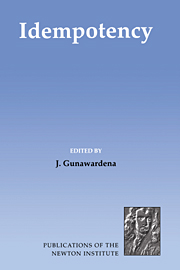Book contents
- Frontmatter
- Contents
- Foreword
- Preface
- List of Participants
- An introduction to idempotency
- Tropical semirings
- Some automata-theoretic aspects of min-max-plus semirings
- The finite power property for rational sets of a free group
- The topological approach to the limitedness problem on distance automata
- Types and dynamics in partially additive categories
- Task resource models and (max, +) automata
- Algebraic system analysis of timed Petri nets
- Ergodic theorems for stochastic operators and discrete event networks.
- Computational issues in recursive stochastic systems
- Periodic points of nonexpansive maps
- A system-theoretic approach for discrete-event control of manufacturing systems
- Idempotent structures in the supervisory control of discrete event systems
- Maxpolynomials and discrete-event dynamic systems
- The Stochastic HJB equation and WKB method
- The Lagrange problem from the point of view of idempotent analysis
- A new differential equation for the dynamics of the Pareto sets
- Duality between probability and optimization
- Maslov optimization theory: topological aspect
- Random particle methods in (max, +) optimization problems
- The geometry of finite dimensional pseudomodules
- A general linear max-plus solution technique
- Axiomatics of thermodynamics and idempotent analysis
- The correspondence principle for idempotent calculus and some computer applications
The topological approach to the limitedness problem on distance automata
Published online by Cambridge University Press: 05 May 2010
- Frontmatter
- Contents
- Foreword
- Preface
- List of Participants
- An introduction to idempotency
- Tropical semirings
- Some automata-theoretic aspects of min-max-plus semirings
- The finite power property for rational sets of a free group
- The topological approach to the limitedness problem on distance automata
- Types and dynamics in partially additive categories
- Task resource models and (max, +) automata
- Algebraic system analysis of timed Petri nets
- Ergodic theorems for stochastic operators and discrete event networks.
- Computational issues in recursive stochastic systems
- Periodic points of nonexpansive maps
- A system-theoretic approach for discrete-event control of manufacturing systems
- Idempotent structures in the supervisory control of discrete event systems
- Maxpolynomials and discrete-event dynamic systems
- The Stochastic HJB equation and WKB method
- The Lagrange problem from the point of view of idempotent analysis
- A new differential equation for the dynamics of the Pareto sets
- Duality between probability and optimization
- Maslov optimization theory: topological aspect
- Random particle methods in (max, +) optimization problems
- The geometry of finite dimensional pseudomodules
- A general linear max-plus solution technique
- Axiomatics of thermodynamics and idempotent analysis
- The correspondence principle for idempotent calculus and some computer applications
Summary
Introduction
The finite automaton [11] is a mathematical model of a computing device. It is very simple and captures the essential features of a sequential circuit. The only difference is that a finite automaton does not produce outputs. Its main objective is to decide whether to accept a given input. The study of finite automata is closely related to the study of regular languages in formal language theory.
Hashiguchi [5] and Simon [18] studied the finite power property problem of regular languages. Hashiguchi's solution is a direct application of the pigeonhole principle. Simon solved the problem by reducing it to the problem of deciding whether a given finitely generated semigroup of matrices over the tropical semiring is finite.
Hashiguchi studied the star height problem and the representation problems for regular languages in ([6], [8], [9]). His solutions relied heavily on the decidability result of the limitedness problem ([7], [10]) for distance automata. Conceptually, the distance automaton is an extension of the finite automaton such that the automaton not only decides whether an input is accepted, but also assigns a measure of cost for the effort to accept the input. In fact, the finite power property problem can be considered as a special case of the limitedness problem.
The nondeterministic behavior of finite automata in connection with their inner structure was considered in ([12], [3], [4]). One important decision problem that arose from this study is a slightly weaker version of the limitedness problem for distance automata.
Motivated by Simon's solution for the finite power property problem, Leung ([14], [15]) also solved the limitedness problem for distance automata by introducing a topological approach and by extending Simon's technique.
- Type
- Chapter
- Information
- Idempotency , pp. 88 - 111Publisher: Cambridge University PressPrint publication year: 1998
- 6
- Cited by

